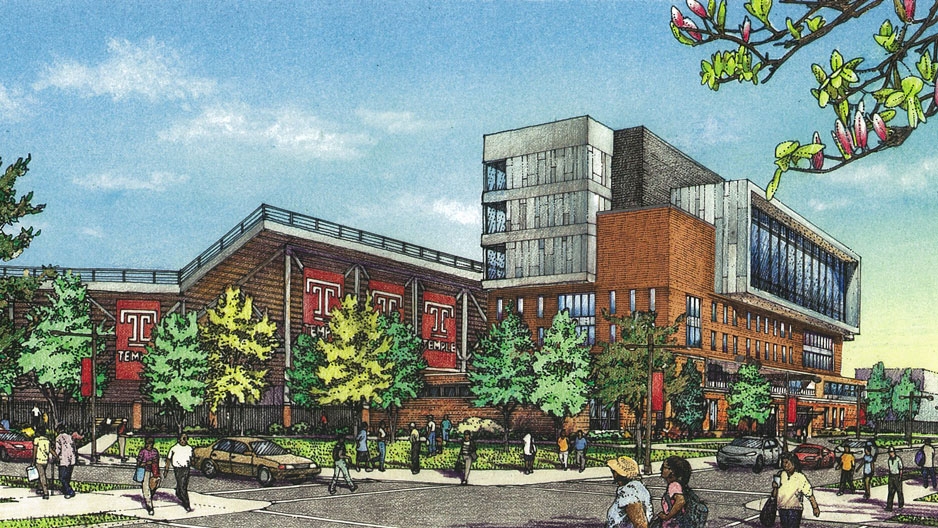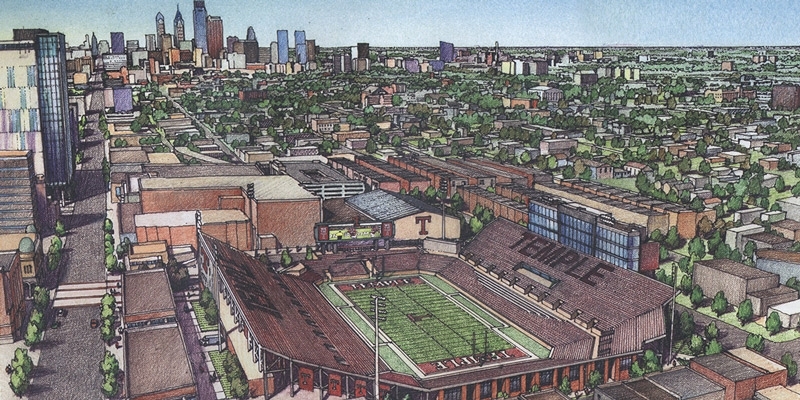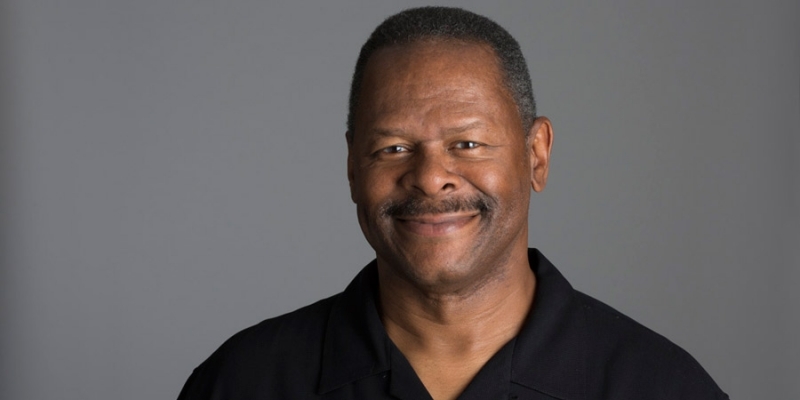Posted April 9, 2018
Temple addresses parking, traffic plans around proposed retail and stadium complex
The athletic, retail and research facility on Main Campus will create a vibrant, pedestrian-focused experience and provide a gathering place for both the university and the community.

Rendering showing the proposed multipurpose facility and stadium complex from 16th and Norris streets
Temple’s proposed multipurpose facility will create a vibrant, pedestrian-focused experience that will be more than an athletic facility. The venue will bring the university and community together by providing a multifaceted space for events, retail, research and more.
As campus is easily accessible via public transit—including two stops on SEPTA’s Broad Street Line, the Temple University Regional Rail station and various bus routes—spectators will be encouraged to use those options. Temple plans to work with SEPTA to explore the possibility of adding transit capacity to handle game-day crowds as needed.
Roughly 10,000 students who live on or around campus are currently bussed to Lincoln Financial Field for Temple football games. These students are expected to arrive to an on-campus stadium on foot, leaving 25,000 remaining game attendees, should the stadium fill to capacity on game day. Based on research, about half of those remaining attendees are expected to take public transit to the game, while the rest are expected to arrive via automobile, explained Dozie Ibeh, associate vice president of Temple’s Project Delivery Group.
Based on studies of other facilities, it is estimated that each automobile will carry up to three people, meaning that at a conservative estimate of 2.5 people per vehicle, 5,000 vehicles would be coming to campus on game days. Temple currently has under its control 5,294 parking spaces, meaning there is ample Temple-controlled parking to accommodate these vehicles. In addition, Temple has identified thousands more parking spaces in lots with easy access to Main Campus via a short walk or public transit and is working to negotiate contracts with owners of these adjacent lots to help absorb parking needs, Ibeh said.
The majority of Temple-controlled parking facilities are east of Broad Street in the interior of campus. Ibeh said the university intends to tell attendees where they will park when they purchase game tickets, so when they arrive on game days, they’ll head to the heart of campus—away from adjacent residential areas—to park. Personnel will be on-hand to ensure that people are able to locate the lots, and Temple is exploring the possibility of working with the city to close some nearby streets to nonresidents to prevent game attendees from parking there.
Temple is confident that spectators will arrive and leave campus smoothly, as they do for basketball games, concerts, graduations and other events. In fact, tens of thousands of people travel to and from campus every day.
Video Production:
Gina Benigno
Using manpower and technology to handle traffic
Temple Police Capt. Jeffrey Chapman said Campus Safety Services has processes in place for controlling traffic during on-campus events, including stationing officers at corners surrounding the venue, extending or shortening traffic lights to expedite flow, using electronic signage to direct drivers to parking lots and partnering with the Philadelphia Police Department to bring in additional traffic officers as needed.
“With game day, we’re talking about a venue larger than the Liacouras Center, so naturally, we’ll have more officers to handle the traffic,” Chapman said. “But the philosophy will be the same—using the technology we have, we’ll get people through as expeditiously as possible.”
Temple is also exploring the possibility of working with ride-share services such as Lyft—which already partners with Temple Athletics—to offer game-day deals and create designated dropoff and pickup locations outside the complex to minimize traffic.
The stadium would necessitate closing a portion of 15th Street, from Norris to Montgomery. Temple has conducted a traffic assessment that included counts at 25 intersections adjacent to the site of the proposed stadium to analyze traffic flow in the area. This determined that roughly 315 vehicles per hour traverse that portion of 15th Street at peak hours.
Temple will work with the city to determine the best way to divert traffic from 15th Street. The university’s preferred option is to send the traffic onto Broad Street and away from the neighborhood. Broad Street currently has a peak traffic count of 2,500 to 3,000 vehicles per hour, but it has the capacity to accommodate more than 5,000 vehicles per hour, meaning that an addition of roughly 315 vehicles would not push Broad Street anywhere near its full capacity.
Defusing tailgating and quality-of-life concerns
Game-day celebrations will be based on a car-free tailgate model that’s been successful at other urban universities, including Tulane in New Orleans. Celebration zones will be designated in the heart of campus, away from residential areas. Chapman said Temple Police will patrol any tailgate areas as well as surrounding neighborhoods to ensure safety and prevent disruptions.
“Between our officers patrolling and Allied Universal bike patrol officers, we’re usually able to identify problem properties and address things before they become an issue. We’ll continue to be proactive in our patrols,” said Chapman, a Temple Police veteran of more than 30 years. “We’re just as concerned about behavior and the relationship of our students and our community. They can always call us to have concerns and issues addressed.”
Read more about the multipurpose facility proposal, including a comprehensive presentation on the project.


